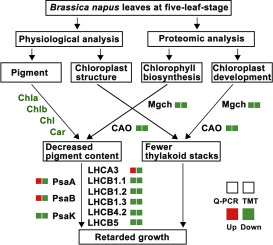当前位置:
X-MOL 学术
›
J. Proteomics
›
论文详情
Our official English website, www.x-mol.net, welcomes your feedback! (Note: you will need to create a separate account there.)
Phenotype and TMT-based quantitative proteomics analysis of Brassica napus reveals new insight into chlorophyll synthesis and chloroplast structure.
Journal of Proteomics ( IF 3.3 ) Pub Date : 2019-12-18 , DOI: 10.1016/j.jprot.2019.103621 Piao Yang 1 , Yaxing Li 2 , Chongsheng He 3 , Jindong Yan 1 , Wei Zhang 4 , Xin Li 1 , Fujiang Xiang 1 , Zecheng Zuo 2 , Xinmei Li 1 , Yonghua Zhu 3 , Xuanming Liu 1 , Xiaoying Zhao 1
Journal of Proteomics ( IF 3.3 ) Pub Date : 2019-12-18 , DOI: 10.1016/j.jprot.2019.103621 Piao Yang 1 , Yaxing Li 2 , Chongsheng He 3 , Jindong Yan 1 , Wei Zhang 4 , Xin Li 1 , Fujiang Xiang 1 , Zecheng Zuo 2 , Xinmei Li 1 , Yonghua Zhu 3 , Xuanming Liu 1 , Xiaoying Zhao 1
Affiliation

|
The conversion of light energy into chemical energy in leaves is very important for plant growth and development. During this process, chlorophylls and their derivatives are indispensable as their fundamental role in the energy absorption and transduction activities. Chlorophyll variation mutants are important materials for studying chlorophyll metabolism, chloroplast biogenesis, photosynthesis and related physiological processes. Here, a chlorophyll-reduced mutant (crm1) was isolated from ethyl methanesulfonate (EMS) mutagenized Brassica napus. Compared to wild type, crm1 showed yellow leaves, reduced chlorophyll content, fewer thylakoid stacks and retarded growth. Quantitative mass spectrometry analysis with Tandem Mass Tag (TMT) isobaric labeling showed that totally 4575 proteins were identified from the chloroplast of Brassica napus leaves, and 466 of which displayed differential accumulations between wild type and crm1. The differential abundance proteins were found to be involved in chlorophyll metabolism, photosynthesis, phagosome and proteasome. Our results suggest that the decreased abundance of chlorophyll biosynthetic enzymes, proteins involved in photosynthesis might account for the reduced chlorophyll content, impaired thylakoid structure, and reduction of plant productivity. The increased abundance of proteins involved in phagosome and proteasome pathways might allow plants to adapt the proteome to environmental conditions to ensure growth and survival due to chlorophyll reduction. BIOLOGICAL SIGNIFICANCE: Photosynthesis, which consists of light and dark reactions, is fundamental to biomass production. Chloroplast is regarded as the main site for photosynthesis. During photosynthesis, the pigment chlorophyll is essential for light harvesting and energy transfer. This work provides new insights into protein expression patterns, and enables the identification of many attractive candidates for investigation of chlorophyll biosynthesis, chloroplast structure and photosynthesis in Brassica napus. These findings may be applied to improve the photosynthetic efficiency by genetic engineering in crops.
更新日期:2019-12-19



























 京公网安备 11010802027423号
京公网安备 11010802027423号